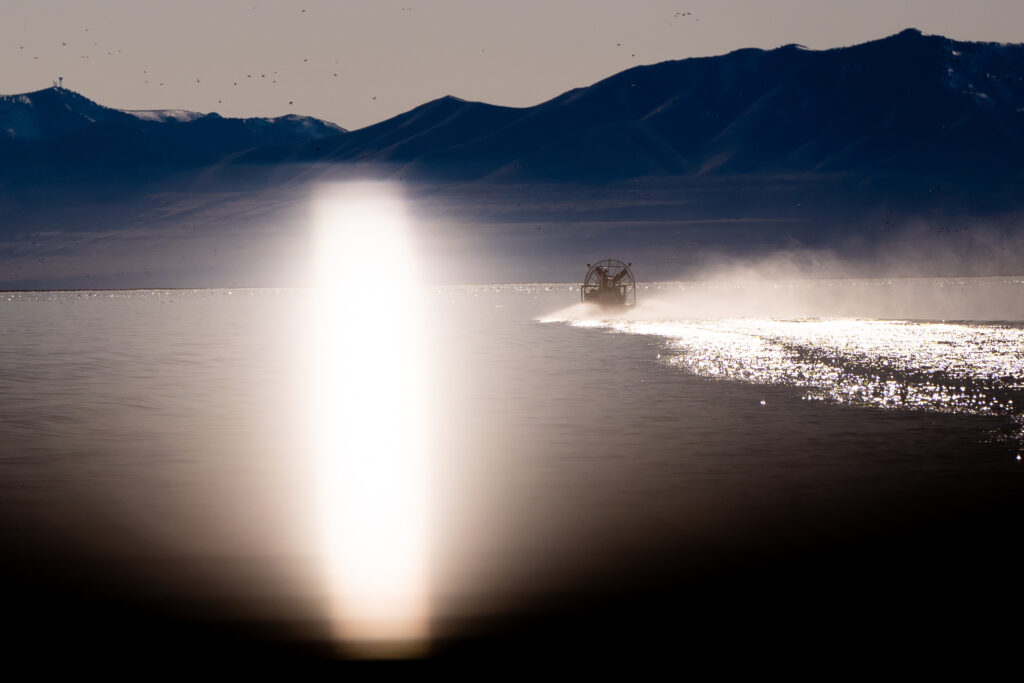Utah News Dispatch
Forecasts predict a hot and dry summer. What does that mean for the Great Salt Lake?


Rep. Blake Moore, R-Utah, and Rep. Jimmy Panetta, D-California, ride an airboat on a tour of the Willard Bay portion of the Great Salt Lake on Monday, March 18, 2024. (Photo by Spenser Heaps for Utah News Dispatch)
Spring runoff flowing into the Great Salt Lake has officials cautiously optimistic, although a dry and warm April is slowing some of that momentum, and a recent report from the National Weather Service is pointing to a hot and dry summer.
“One of the reasons we haven’t seen more gains on the Great Salt Lake over the last month, I’m sure, is because we had such a warm and windy April and you start to see some of that evaporative loss. If that continues into the summer, we would anticipate higher evaporation losses as well and that’s something that would concern all of us,” said Great Salt Lake Commissioner Brian Steed.
The National Weather Service Climate Prediction Center recently released a three month outlook for temperatures heading into the summer — the report points to above average temperatures for much of the intermountain West and Southwest, with about 50% to 60% probability of higher than normal heat in Utah during June, July and August.
The outlook for precipitation is similar for Utah, with parts of the state expected to see below or slightly below normal amounts of rain during the summer months.
The warm spring means a rapidly melting snowpack. The snow water equivalent, which is basically the amount of water in the snowpack, was at about 127% of normal last Saturday — as of Wednesday, it was at 111% of normal.
Still, healthy reservoir levels around the state mean local water districts will continue to release flows into the Great Salt Lake Basin tributaries. Most reservoirs in the basin are sitting at about 85% capacity or higher, which is above average for this time of year. They’re looking “remarkably healthy,” Steed said on Wednesday during a media briefing on the lake.
GET THE MORNING HEADLINES DELIVERED TO YOUR INBOX
“Because of that and because there still is above average snowpack coming down into those reservoirs, we expect further releases,” Steed said, telling reporters water districts will continue those releases into the summer.
So far, about 85,000 acre feet of water has made it from Utah Lake into the Great Salt Lake, Steed said; about 113,100 acre feet has moved through Willard Bay in Box Elder County; and an additional 202,037 has been recorded at the Plain City gauge, west of North Ogden. And the Bear River, the Great Salt Lake’s largest tributary, is conveying about 4,836 acre feet each day (an acre foot is enough water to submerge an acre of land by one foot).
“That’s great news, and we look forward to seeing those recoveries continue given where we are with snowpack and runoff,” Steed said.
That water has resulted in lake levels slowly creeping higher, with the south arm up about six feet from its historic low point in 2022. As of Wednesday, state data recorded the south arm at 4,194.7 feet, “which is good, not great, but we’ll take it.” Steed said.
That puts the lake about three feet away from the bottom of the spectrum of what’s considered a healthy level, 4,198 feet. Steed said unless Utah sees a continued series of great winters, like what happened in 2023, he doesn’t expect the lake to hit that level for a handful of years.
“We’re going to be in this for the long haul,” he said, noting that an estimated 400,000 additional acre feet would be required to make up the difference. “That’s a tall order,” he said.
And as the lake fills, it also spreads out — that can lead to increased losses due to evaporation as the lake creeps into more shallow areas that are exposed and susceptible to heating.
Water levels at the Great Salt Lake typically peak around the beginning of May — last year’s historic winter pushed the peak back to the end of June. Steed said this year will likely land somewhere in between, or at least a little beyond early May.
Salinity levels are also sitting at much lower levels compared to last year, Steed said. That’s resulting in a healthy population of brine flies which in turn will help the migratory bird population.
The post Forecasts predict a hot and dry summer. What does that mean for the Great Salt Lake? appeared first on Utah News Dispatch.



















